当代美国社会与文化
- 格式:doc
- 大小:34.00 KB
- 文档页数:6
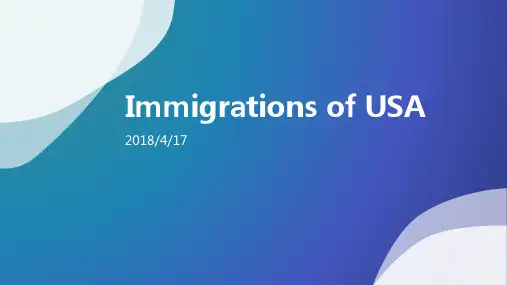
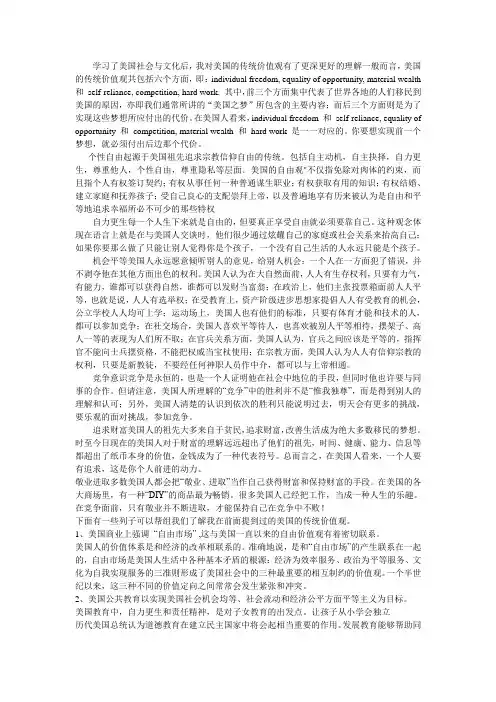
学习了美国社会与文化后,我对美国的传统价值观有了更深更好的理解一般而言,美国的传统价值观共包括六个方面,即:individual freedom, equality of opportunity, material wealth 和self-reliance, competition, hard work. 其中,前三个方面集中代表了世界各地的人们移民到美国的原因,亦即我们通常所讲的“美国之梦”所包含的主要内容;而后三个方面则是为了实现这些梦想所应付出的代价。
在美国人看来,individual freedom 和self-reliance, equality of opportunity 和competition, material wealth 和hard work 是一一对应的。
你要想实现前一个梦想,就必须付出后边那个代价。
个性自由起源于美国祖先追求宗教信仰自由的传统。
包括自主动机,自主抉择,自力更生,尊重他人,个性自由,尊重隐私等层面。
美国的自由观"不仅指免除对肉体的约束,而且指个人有权签订契约;有权从事任何一种普通谋生职业;有权获取有用的知识;有权结婚、建立家庭和抚养孩子;受自己良心的支配崇拜上帝,以及普遍地享有历来被认为是自由和平等地追求幸福所必不可少的那些特权自力更生每一个人生下来就是自由的,但要真正享受自由就必须要靠自己。
这种观念体现在语言上就是在与美国人交谈时,他们很少通过炫耀自己的家庭或社会关系来抬高自己;如果你要那么做了只能让别人觉得你是个孩子,一个没有自己生活的人永远只能是个孩子。
机会平等美国人永远愿意倾听别人的意见,给别人机会;一个人在一方面犯了错误,并不剥夺他在其他方面出色的权利。
美国人认为在大自然面前,人人有生存权利,只要有力气,有能力,谁都可以获得自然,谁都可以发财当富翁;在政治上,他们主张投票箱面前人人平等,也就是说,人人有选举权;在受教育上,资产阶级进步思想家提倡人人有受教育的机会,公立学校人人均可上学;运动场上,美国人也有他们的标准,只要有体育才能和技术的人,都可以参加竞争;在社交场合,美国人喜欢平等待人,也喜欢被别人平等相待,摆架子、高人一等的表现为人们所不取;在官兵关系方面,美国人认为,官兵之间应该是平等的,指挥官不能向士兵摆资格,不能把权威当宝杖使用;在宗教方面,美国人认为人人有信仰宗教的权利,只要是新教徒,不要经任何神职人员作中介,都可以与上帝相通。

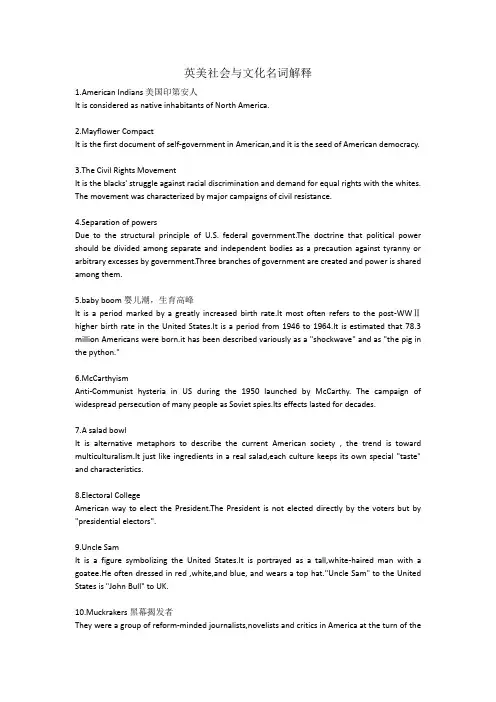
英美社会与文化名词解释1.American Indians美国印第安人It is considered as native inhabitants of North America.2.Mayflower CompactIt is the first document of self-government in American,and it is the seed of American democracy.3.The Civil Rights MovementIt is the blacks' struggle against racial discrimination and demand for equal rights with the whites. The movement was characterized by major campaigns of civil resistance.4.Separation of powersDue to the structural principle of U.S. federal government.The doctrine that political power should be divided among separate and independent bodies as a precaution against tyranny or arbitrary excesses by government.Three branches of government are created and power is shared among them.5.baby boom婴儿潮,生育高峰It is a period marked by a greatly increased birth rate.It most often refers to the post-WWⅡhigher birth rate in the United States.It is a period from 1946 to 1964.It is estimated that 78.3 million Americans were born.it has been described variously as a "shockwave" and as "the pig in the python."6.McCarthyismAnti-Communist hysteria in US during the 1950 launched by McCarthy. The campaign of widespread persecution of many people as Soviet spies.Its effects lasted for decades.7.A salad bowlIt is alternative metaphors to describe the current American society , the trend is toward multiculturalism.It just like ingredients in a real salad,each culture keeps its own special "taste" and characteristics.8.Electoral CollegeAmerican way to elect the President.The President is not elected directly by the voters but by "presidential electors".9.Uncle SamIt is a figure symbolizing the United States.It is portrayed as a tall,white-haired man with a goatee.He often dressed in red ,white,and blue, and wears a top hat."Uncle Sam" to the United States is "John Bull" to UK.10.Muckrakers黑幕揭发者They were a group of reform-minded journalists,novelists and critics in America at the turn of the20th century.They exposed various dark sides of the seemingly prosperous society.They gave rise to the Progressive movement.11.Rosa Parks IncidentRosa Parks is a middle-aged black woman.She refused to give up her seat on the bus to a white passenger who had just gotten on.Then Rosa was arrested and fined 10 dollars.This insident led to a 1956 Supreme Court decision banning segregated buses.12.A nation of nations万民之邦The US has long been known as a nation of immigration,a multinational and multiracial country.The vast majority of its population is immigrants or descendants of immigrants coming from all over the world.13.New EnglandIn 1620,pilgrims from England first settled in New England to form plymouth Colony.But now,it is a region in the northeastern comer of the United States consisting of the 6 states.14.WASPsIt refers to the White Anglo-Saxon Protestants and their descendants.They are Americans of English ancestry.Until quite recently,to many peopie the WASPs had been the Americans.Their culture had represented the American culture.The WASPs still dominate every aspect of American life.。
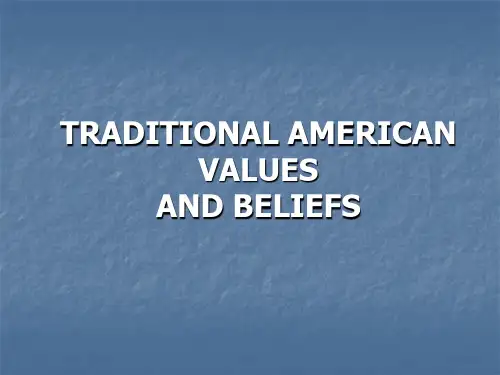
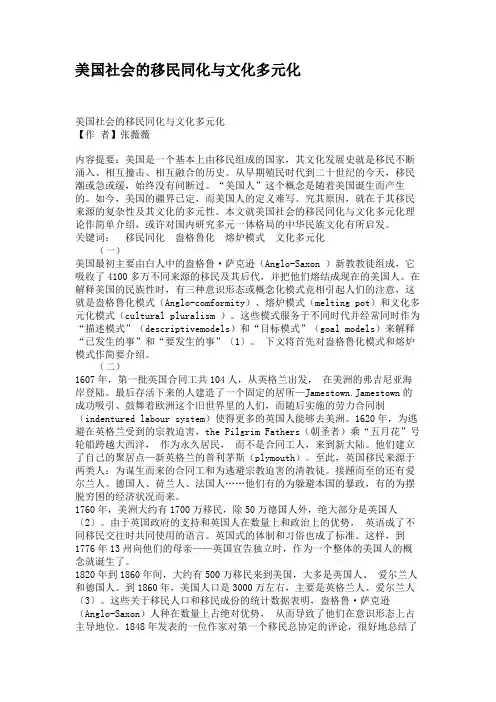
美国社会的移民同化与文化多元化美国社会的移民同化与文化多元化【作者】张薇薇内容提要:美国是一个基本上由移民组成的国家,其文化发展史就是移民不断涌入、相互撞击、相互融合的历史。
从早期殖民时代到二十世纪的今天,移民潮或急或缓,始终没有间断过。
“美国人”这个概念是随着美国诞生而产生的。
如今,美国的疆界已定,而美国人的定义难写。
究其原因,就在于其移民来源的复杂性及其文化的多元性。
本文就美国社会的移民同化与文化多元化理论作简单介绍,或许对国内研究多元一体格局的中华民族文化有所启发。
关键词:移民同化盎格鲁化熔炉模式文化多元化(一)美国最初主要由白人中的盎格鲁·萨克逊(Anglo-Saxon )新教教徒组成,它吸收了4100多万不同来源的移民及其后代,并把他们熔结成现在的美国人。
在解释美国的民族性时,有三种意识形态或概念化模式竞相引起人们的注意,这就是盎格鲁化模式(Anglo-comformity)、熔炉模式(melting pot)和文化多元化模式(cultural pluralism )。
这些模式服务于不同时代并经常同时作为“描述模式”(descriptivemodels)和“目标模式”(goal models)来解释“已发生的事”和“要发生的事”〔1〕。
下文将首先对盎格鲁化模式和熔炉模式作简要介绍。
(二)1607年,第一批英国合同工共104人,从英格兰出发,在美洲的弗吉尼亚海岸登陆。
最后存活下来的人建造了一个固定的居所—Jamestown.Jamestown的成功吸引、鼓舞着欧洲这个旧世界里的人们,而随后实施的劳力合同制(indentured labour system)使得更多的英国人能够去美洲。
1620年,为逃避在英格兰受到的宗教迫害,the Pilgrim Fathers(朝圣者)乘“五月花”号轮船跨越大西洋,作为永久居民,而不是合同工人,来到新大陆。
他们建立了自己的聚居点—新英格兰的普利茅斯(plymouth)。
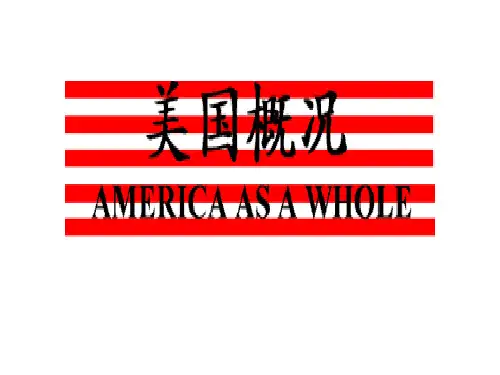
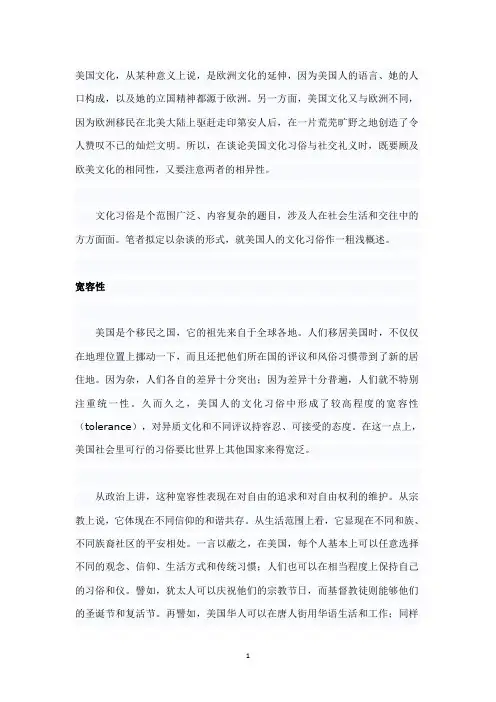
美国文化,从某种意义上说,是欧洲文化的延伸,因为美国人的语言、她的人口构成,以及她的立国精神都源于欧洲。
另一方面,美国文化又与欧洲不同,因为欧洲移民在北美大陆上驱赶走印第安人后,在一片荒芜旷野之地创造了令人赞叹不已的灿烂文明。
所以,在谈论美国文化习俗与社交礼义时,既要顾及欧美文化的相同性,又要注意两者的相异性。
文化习俗是个范围广泛、内容复杂的题目,涉及人在社会生活和交往中的方方面面。
笔者拟定以杂谈的形式,就美国人的文化习俗作一粗浅概述。
宽容性美国是个移民之国,它的祖先来自于全球各地。
人们移居美国时,不仅仅在地理位置上挪动一下,而且还把他们所在国的评议和风俗习惯带到了新的居住地。
因为杂,人们各自的差异十分突出;因为差异十分普遍,人们就不特别注重统一性。
久而久之,美国人的文化习俗中形成了较高程度的宽容性(tolerance),对异质文化和不同评议持容忍、可接受的态度。
在这一点上,美国社会里可行的习俗要比世界上其他国家来得宽泛。
从政治上讲,这种宽容性表现在对自由的追求和对自由权利的维护。
从宗教上说,它体现在不同信仰的和谐共存。
从生活范围上看,它显现在不同和族、不同族裔社区的平安相处。
一言以蔽之,在美国,每个人基本上可以任意选择不同的观念、信仰、生活方式和传统习惯;人们也可以在相当程度上保持自己的习俗和仪。
譬如,犹太人可以庆祝他们的宗教节日,而基督教徒则能够他们的圣诞节和复活节。
再譬如,美国华人可以在唐人街用华语生活和工作;同样的道理,越南移民能够在他们的“小西贡”按越南的方式经营业务,从事各种活动。
美国人的容忍性,除了上面的美国是个移民国这个因素以外,还与美国人的频繁迁徙有关。
众所周知,美国历史发展中的一个重要部分是她的西部开发史。
那时,美国拓荒者或徒步跋涉,或骑马坐车,从东到西,从南到北,哪里有机遇,就往那里移居。
频繁的迁移和不断地更换居处使人们始终处于“流动”状态,对暂面临的种种不同现象更易于宽容和接受。
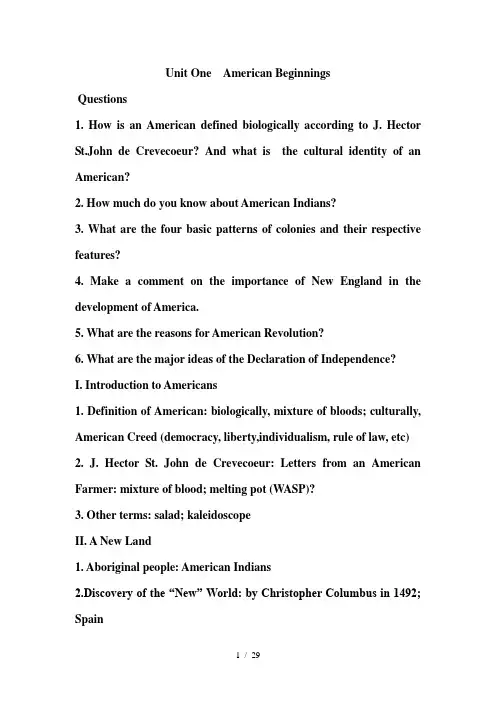
Unit One American BeginningsQuestions1. How is an American defined biologically according to J. Hector St.John de Crevecoeur? And what is the cultural identity of an American?2. How much do you know about American Indians?3. What are the four basic patterns of colonies and their respective features?4. Make a comment on the importance of New England in the development of America.5. What are the reasons for American Revolution?6. What are the major ideas of the Declaration of Independence?I. Introduction to Americans1. Definition of American: biologically, mixture of bloods; culturally, American Creed (democracy, liberty,individualism, rule of law, etc)2. J. Hector St. John de Crevecoeur: Letters from an American Farmer: mixture of blood; melting pot (WASP)?3. Other terms: salad; kaleidoscopeII. A New Land1. Aboriginal people: American Indians2.Discovery of the “New” World: by Christopher Columbus in 1492; Spain3. North America: John Cabot (from Italian) in 1497; England4. Background of colonization: the development of capitalism; the Renaissance; the Religious Reformation (Christianity: Roman Catholic; Protestantism; Eastern Orthodoxy)5. Roman Catholic: Pope, hierarchyProtestantism (protest + ant + ism): the BiblePuritan (purify the Church of England): working hard; living a moral life; thriftInfluence of Puritan beliefs: individualism; hard work; respect of education.III. Four Patterns of Colonies1. 13 colonies: New Hampshire, Massachusetts, Rhode Island, Connecticut, New York, New Jersey, Pennsylvania, Delaware, Maryland,Virginia, North Carolina, South Carolina, and Georgia.2. Virginia: adventurous English gentlemen; for economic reasons; Jamestown (the first English permanent settlement); tobacco; the House of Burgesses (representative assembly) and the enslavement of blacks in 16193. New England (Massachusetts 马萨诸塞, Connecticut康涅狄克, New Hampshire新罕布什尔, Vermont佛蒙特, Maine缅因, Rhode Island罗德岛):Mayflower (1620); English puritans; for religious freedom; the Mayflower Compact (a civil government自治政府); a city upon hill (山巅之城); the core of American resistance in the War of Independence; evolved representative government(代议制); religious persecution3. Maryland: Catholics; religious freedom4. Pennsylvania: Quaker(quake + er 贵格派); equality; brotherhood; religious freedom; separation of state and church; a liberal self-governmentIV. American Revolution1. Reasons: new taxes on sugar, coffee, textiles and other imported goods; the Stamp Act(印花税); the Quartering Act(驻军食宿法); “No taxation without representation”2. Beginning: the Boston Tea Party(波士顿倾茶党)in 1773; the First Continental Congress in 1774; the first shot in Concord in 17753. Process: the Second Continental Congress(第二届大陆会议)in 1775; the Declaration of Independence on July 4, 1776;4. End: came to an end in 1781; theTreaty of Paris(《巴黎和约》)in 1783Unit 2 The American Political SystemArticles of Confederation●Relationships between the 13 colonies after the War of Independence: like 13 independent states (with their own government, their own laws and responsibility for handling their own internal affairs)●Articles of Confederation: a loose union, which could deal with only problems and needs beyond the power of individual states (i.e., raise money to pay off debts of the war, establish a money system, make treaties with foreign nations); obvious disadvantagesConstitution●Constitutional Convention: began in May of 1787, with delegates from 12 states (except Rhode Island); from making changes necessary to strengthen the Articles of Confederation to making a new constitution●Constitution: 1. federal system: share power between the federal government and state governments; 2. division of power: the executive, the judicial, the legislative; 3. checks and balances●Weakness: no explicit guarantees of the freedoms or the basic rights of citizens●Checks and balances: a principle of government under which separate branches are empowered to prevent actions by otherbranches and are induced to share power. This system was enacted through the Constitution of the United States in order to prevent any of its three branches from dominating the Federal government.Division of Power●The legislative: make federal laws, levy federal taxes, declare war, put foreign treaties into effect.●The executive (the president): formulate public policy, propose legislation to Congress, veto a bill, appoint federal judges, act as commander in chief of the armed forces, be responsible for foreign relations, negotiate treaties with other countries.●The judicial: jurisdiction over cases arising out of the Constitution; national laws and treaties; maritime cases; issues involving foreign citizens or governments; and cases in which the federal government itself is a party; judicial review(司法复审, the power to determine whether congressional legislation or executive action violates the Constitution).Formation of the Three Branches●The legislative branch (Congress): the House of Representatives (two-year terms, and varying numbers of seats for different states based on population) and the Senate (for six-year terms, two seats for each state); lobby●The executive branch: the President and the Cabinet (composed ofsecretaries of different departments); federal workers●The judicial: the Supreme Court / 最高法院(composed of 1 chief justice / 首席大法官and eight associate justices大法官), 11 federal courts of appeal(联邦上诉法院), and 91 federal district courts(联邦地方法院).●To assure the independence of federal judges: work for life or voluntary retirement.Bill of Rights●Bill of Rights: adopted in 1791; consisting of 10 amendments to the Constitution, guaranteeing freedom and individual rights and forbidding interference with lives of individuals by the government.●Freedom: of speech, of religion, of the press.●Rights: to assemble in public places, to pretest government actions, to demand change, to own weapons, to a speedy trial by a jury and to be represented by a lawyer and to call in witnesses.Political Parties●Bipartisan system: the Democratic Party (the more liberal party, symbolized by the donkey) & the Republican Party (the more conservative party, symbolized by the elephant).●High cost of campaigning for public officesQuestions1. What kind of government was established based on the Articles ofConfederaion?2. What is the Constitution mainly about?3. What are the major principles for the establishment of American government?4. What is the definition of federal system?5. Why was it necessary to establish “Bill of Rights”?6. What are the major responsibilities of the legislative branch?7. What are the procedures to make a law?8. What does lobby mean?9. What power does American President have?10. What are the major responsibilities of the judicial branch?11. How do you und erstand the principle of “checks and balances”?12. How was American party politics developed?American economyUnit 3 American EconomyIndustrial Revolution●Change from an agricultural country to an industrial country●Debate about the road to development: agriculture (represented by Thomas Jefferson) vs industry (represented by Alexander Hamilton) ●Thomas Jefferson’s ideas about farmers (see p. 74)●Alexander Hamilton(亚历山大·汉密尔顿): the first Secretary of the Treasury(财政部长)and the co-author of The Federalist Papers (《联邦党人文集》); believe in a strong central government and a strong national bank.●Hamiltonian measures: “Report on the Public Credit”; “Report ona National Bank”; “Report on Manufactures” (protective tariff).●Industrial revolution in America: 1. the introduction of the factory system (Samuel Slater); 2. the American system of mass production (Eli Whitney) and scientific management (by Frederick Tylor); 3. the application of new technologies to industrial tasks; 4. the emergence of new forms of business organizations (represented by bank and corporation); 5. the construction of railroads.●Scientific management: a theory of management that analyzes and synthesizes workflows, with the objective of improving labour productivity. It is composed of job design (to ensure that employees will not be asked to perform work beyond their abilities) anddividion of labor. It can be used to refer to any system of organization that clearly spells out the functions of individuals and groups.●Post-industrial era: a period in the develop-ment of an economy or nation in which the relative importance of manufacturing lessens and that of services, information, and research grows. Five primary characteristics: 1. the domination of service, rather than manufacturing or industry; 2. the preeminence of the professional and technical classes; 3. the central place of theoretical knowledge as a source of innovations; 4. the dominating influence of technology; 5. levels of urbanization higher than anywhere else in the world.Free EnterpriseLaissez faire(自由放任): An economic doctrine that opposes governmental regulation of or interference in commerce beyond the minimum necessary for a free-enterprise system to operate according to its own economic laws.●Disadvantages: monopoly, elimination of competition, higher price, poor quality products●Adam Smith: author of An Inquiry into the Nature and Causes of the Wealth of Nations, (abbreviated as Wealth of Nations 《国富论》), founder of free market economics (markets are driven toward the public good by an "invisible hand" ).Roots of Affluence●Bountiful resources; geographical size; population trends; religious, social and political traditions; the institutional structures of government and business; hard work.Agriculture●The foundation of American economy●Major crops: soybeans, corn, cotton, wheat, tobacco, vegetable oils ●Agribusiness: the entire complex of farm-related businesses, including farmer cooperatives, rural banks, shippers of farm products, commodity dealers, firms that manufacture farm equipment, food processing industries, grocery chains, and many other businesses.●Problems: environmental pollutionUnit Four American ReligionI. Importance of Religion●A religious people: 94% believe in God; 90% pray; 57% are members of a church; 40% attend a church weekly.●A major purpose of colonization: religious freedom (in a relative sense, i.e., greater religious freedom in America than in European countries); the elect of God●A major factor of America’s ra pid development●An important aspect of American identity: WASP (White Anglo-Saxon Protestant)●Basic documents and religion: The Declaration of Independence (Creator; Nature’s God); the First Amendment to the Constitution (free practice of religion; no state or national religion)●Definition of faith heeling: curing of an illness or disability by recourse to divine power, without the use of traditional medicine. Example: “Faith-Healing Parents Given Jail Sentence” (Oct. 7, 2009): A couple from Wisconsin, who prayed rather than seeking medical care for their 11-year old daughter who died of an undiagnosed but treatable form of diabetes(糖尿病), were sentenced to 6 months in jail and 10 years probation.II. Christianity●The actual national religion, with a population of 87%●Protestantism: 60% of the population; major sects: Baptist(洗礼教派); Methodist(卫理公会教徒); Presbyterian(长老会教友); Episcopalian(新教圣公会教徒)●Roman Catholics: ¼ of all Americans; Anti-Catholic prejudice; John F. Kennedy, the first Roman Catholic presidentIII. Civil Religion●Bring together secular politics and religious society●Four major elements: 1. the religious basis of the American system of government (President Eisenhower: “Recognition of the Supreme Being is the first, the most basic expression of Americanism. Without God, there could be no American form of government, nor an American way of life.” 2. the beliefs that Americans are God’s chosen and that American people have a special destiny under God (Manifest Destiny). 3. the prevalence of religious allusions and symbols in American public rhetoric, rituals, and ceremonies. (the use of the Bible and the invocation of God in Presidents’ inaugural addresses; the appearance of “In God We Trust” in American currency, bills and coins; the use of prayer in opening the daily sessions of Congress.) 4. the religious aura in national ceremonies and activities (Memorial Day, Thanksgiving Day, presidential inaugurations and funerals)IV. Religious Diversity●1,000 denominations, sects, and cults●Judaism: 1. characteristics (its monotheism; its belief in a special covenant with God making it His ‘chosen people’; ethnic and territorial identity, i.e., “the promised land”; specific laws and practices; and Messianism); 2. anti-Jewish prejudice /anti-semitism;3. intellectual leaders●Islam●BuddhismV. American Character of Religion●1. The harmonious co-existence of various religions●2. The co-existence of strong religious beliefs and social progress●3. Independence of church in terms of finance and building, and little concentration on doctrine or religious argumentVI. Religion and American Political Culture●The covenant theology and the right to revolt●Puritanism and democracy●One nation under God: a sense of mission (Manifest Destiny)Unit Five Education in the United StatesI. Importance of Education●A long history of higher education (longer than the history of the nation): the establishment of universities before the independence of America (three oldest universities in the colonial period, i.e., Harvard College in 1636, the College of William & Mary in 1693, and Y ale University in 1701); reasons for the development of higher education (well-educated early immigrants; the necessity to read the Bible)●An important factor contributing to the rapid development of America: teaching knowledge and skills●The basis of democracy: equal opportunity based on education; enhancing social mobility●Base of national unity: assimilation and Americanization.II. Constitutional Status of Public Education●According to the Tenth Amendment to the Constitution: The power for public education is reserved to the states or the people●No federally controlled and administered school system (the establishment of the U.S. Office of Eduation in 1867 as a part of the Department of Health, Education and Welfare, and the establishment of U.S. Department of Education in 1979): diversity in American educationIII. Two School Systems●Public school: supported by state governments; attended by 90% of American students; controlled by boards of education; sources of income: government funding; student tuition; endowments by wealthy benefactors.●Private school: supported by religious groups or non-religious individuals /organizations; attended by 10% of American students; run privately; sources of income:student tuition; endowments by wealthy benefactors; government funding.IV. Structure of American Education●1. Elementary school: including grades kindergarten through 8; also known as grammar school●2. Secondary school: includi ng grades 9~12; popularly called “high school” (junior high school & senior high school): Junior high school: a school in the U.S. system which generally includes the seventh, eighth, and sometimes ninth grades; Senior high school: a high school usually constituting grades 10, 11, and 12●3. Higher education: the two-year college (junior college or community college); the technical training institution; the four-year undergraduate institution (the college); the university (granting a master’s or doctoral de gree).●Academic degrees: associate degree (granted by community colleges); bachelor’s degree; master’s degree; doctoral degree.V. Criteria for Selecting Applicants1. High school records2. Recommendations from high school teachers3. Impression during the interview at the university4. Scores on the Scholastic Aptitude Tests (a kind of standardized test VI. Affirmative Action●Definition: a program that seeks to redress past discrimination through active measures to ensure equal opportunity, as in education and employment.●Two purposes: eliminate discrimination & redress the effects of past discrimination●Reverse discrimination(反向歧视): discrimination against members of a dominant or majority group, especially when resulting from policies established to correct discrimination against members of a minority or disadvantaged group.Unit Six Social Movements in the 1960sI. Criteria of Social Movements●Ideas for social change●Collective action●organizationII. Major Social Movements: 1. Civil Rights Movement●Definition: a movement for racial equality in the U.S. that, through nonviolent protest, broke the pattern of racial segregation in the South and achieved equal rights legislation for blacks.●Origin of the movement: Rosa Parks’ refusal to give her seat in the front of a bus to a white man in 1955.●Formal beginning of the movement: sit-in in 1960●Nonviolent tactics (advocated by Martin Luther King): boycotts; Sit-in (first used by black students in Greensboro, North Carolina in 1960); freedom rides; vote registration●Violent tactics (advocated by Malcom X): armed organization (the Black Panther Party); separatism; black power●Sit-in(静坐示威): an organized protest demonstration in which participants seat themselves in an appropriate place and refuse to move.●Teach-in(大学师生举行的讨论会或宣讲会): an extended session, as on a college or university campus, for lectures and discussions onan important, usually controversial issue.●Freedom ride(自由乘车运动): civil rights activists’ ride on interstate buses into the south of the United States to fight racial segregation.●Black Power(黑人权力): a movement among African Americans emphasizing racial pride and social equality through the creation of Black political and cultural institutions.●NAACP (the National Association for the Advancement of Colored People /全国有色人种协进会): the oldest and largest U.S. civil rights organization which was founded in 1909 to secure political, educational, social, and economic equality for African Americans.●SNCC (the Student Nonviolent Coordinating Committee /学生非暴力统一行动委员会)●CORE (the Congress of Racial Equality /争取种族平等大会)●SCLC (the Southern Christian Leadership Conference /南部基督教领导联合会)●The Black Panther Party for Self-Defense(黑豹党): an organization of African American militants for the purpose of protecting African Americans from acts of police brutality.●Martin Luther King, Jr.: an African-American clergyman who advocated social change through non-violent means; the Nobel Peace Prize winner in 1964; assassinated in 1968.●Malcom X: a black Moslem leader who advocated black separatism and was against nonviolence in fighting discrimination and racism.II. Major Social Movements: 2. The Youth Movement / Anti-War Movement●The Beat Generation: a group of American writers and artists popular in the 1950s and early 1960s, influenced by Eastern philosophy and religion and known especially for their use of nontraditional forms and their rejection of conventional social values.●Counterculture(反文化): a culture, especially of young people, with values or lifestyles in opposition to those of the established culture or the social mainstream.●Hippies(嬉皮士): a person who opposes and rejects many of the conventional standards and customs of society, especially one who advocates extreme liberalism in sociopolitical attitudes and lifestyles.●Flower children: a hippie, especially one advocating universal peace and love as antidotes to social or political ills●Anti-Vietnam War: teach-ins, protest marches and rallies, destroying draft recordsIV. Major Social Movement s: 3. The Women’s Movement●Three groups of women: professional women; white housewives and mothers; young activists in the civil rights and anti-warmovements.●The Civil Rights Act of 1964: Discrimination in employment based on race or sex is illegal.●Goals: equal pay for equal work; equality in job opportunities; recognition of equality in intelligence or ability.V. Achievements●The end of legal segregation●US withdrawal of troops from the Vietnam War and the signing ofa peace treaty in 1973●The im provement of women’s status both at home and in societyUnit Seven Social ProblemsI. Racial Problems●Mainstream / majority: WASP●Minority groups: African Americans, Native Americans (American Indians), the Hispanics, Asian Americans●Involuntary citizens: Native Americans, African Americans, Mexican Americans and Puerto Ricans●Native Americans: forcibly conquered with their homelands taken away; reservations●African Americans: captured, transported, enslaved; lynched; segregated (ghetto); discrimination; myth of racial inferiority: irresponsibility (childish); promiscuity (myth of black rapist and anti-miscegenation laws); laziness; lower intelligence●Mexican Americans and Puerto Ricans: occupied through wars●Racial profiling(种族成见/种族脸谱化/种族定型化): a form of racism consisting of the (alleged) policy of policemen who stop and search vehicles driven by persons belonging to particular racial groups; the inclusion of racial or ethnic characteristics in determining whether a person is considered likely to commit a particular type of crime or an illegal act or to behave in a "predictable" manner.II. Poverty●Percentage of poor people: 12.5% in 2003●Poverty threshold / poverty line: the minimum level of income deemed necessary to achieve an adequate standard of living in a given country●Absolute poverty: the absence of enough resources (such as money) to secure basic life necessities●Relative poverty (moderate poverty): a standard of living or level of income that is high enough to satisfy basic needs, but still significantly lower than that of the majority of the population under consideration●Influential scholars: John Kenneth Galbraith(约翰·肯尼斯·加尔布雷斯): “People are poverty-stricken when their income, even if adequate for survival, falls markedly behind that of the community.” (The Affluent Society, 1958); Michael Harrington(迈克尔·哈林顿): Americans living without adequate nutrition, housing, medical care, and education—people deprived of the standard of living shared by the rest of society (The Other America: Poverty in the United States, 1960)●Poor people: children; the elderly, single-parent families; rural Americans; nonwhites●Measures: the welfare system; day care for children, health care, work-training, special programs for agricultural workers, and freelegal assistance●Historical efforts: President John F. Kennedy's support of antipoverty proposals; “War on Poverty” in President Lyndon B. Johnson’s 1964 inaugural speech and his Great Society program. III. Drug Abuse●A major threat to American society●Kinds of drugs: heroin, cocaine, marijuana●Typical examples: President Obama; Michael Phelps(迈克尔·菲尔普斯)●Serious consequences: crime; automobile accidents; suicide; infectious diseases; economic lossesIV. Crime●One of the most serious social problems●Traditional crimes: rape, murder, robbery, arson, burglary, aggravated assault, auto theft, larceny, prostitution.●Features of criminals: male; young; members of racial minority groups; city residents●white-collar crime: fraud, false advertising, corporate price fixing, bribery, embezzlement, industrial pollution, tax evasion.●Features of criminals: older, wealthier, whiter, more suburbanV. Abuse of Power●Watergate: a series of scandals occurring during the Nixonadministration in which members of the executive branch organized illegal political espionage against their perceived opponents and were charged with violation of the public trust, bribery, contempt of Congress, and attempted obstruction of justice.●Monicagate / Levinsky scandal: the sexual scandal between President Bill Clinton and Monica S. Lewinsky, an unpaid intern and later a paid staffer at the White House in 1995-96.●Lobby / interest groups / pressure groups: a group whose members share certain goals and work to bring about the passage, modification, or defeat of laws that affect these goals.Unit Eight American Foreign PolicyI. Foreign Policy Concepts / Theories1. Idealism(理想主义): aim to use the state's influence and power to promote higher liberal ideals like peace, justice and co-operation between nations; collective security and the equality of nations.2. Realism(现实主义): stress the promotion of a state's "narrow" and amoral self-interest; balance of power;II. US foreign policy concepts●Idealism: the elect of God; a city upon hill; manifest destiny; a tool of foreign policy, i.e., used to sell foreign policy to the American people and the wider world.●“American exceptionalism”: a term used to describe the belief that the United States is an extraordinary nation with a special role to play in human history; a nation that is not only unique but also superior.●Manifest Destiny(显然天命): the 19th-century doctrine that the United States had the right and duty to expand throughout the North American continent.●President Woodrow Wilson (during World War I) as a typical example of idealism: doctorate & president of Princeton College, Nobel Peace Prize winner in 1919; make the world safe for democracy; fourteen points; the League of Nations.III. Features of US Foreign Policy●Duality: to protect national interests and the nation from external threats in a hostile world and to stand for ideals worthy of emulation ●The Truman Doctrine(杜鲁门主义): Ideally, to establish a safer democratic world in which people could live free of communist tyranny; realistically, to contain Communism.●The Gulf War: Ideally, to promote democracy and improve human rights; realistically, for oil.●President Clinton: “Democracies don’t attack each other.” (1994) ; strengthen American power and push for worldwide acceptance of the democratic virtues that underpin America's liberal political culture.IV. US Foreign Policy:Isolationism(孤立主义)●Definition: opposition to intervention in a war outside the western hemisphere, particularly in Europe; to involvement in permanent military alliances; and to participation in organizations of collective security; seeking to preserve the United State’s freedom of action.●Development of isolationism: Thomas Paine called for an independent foreign policy in Common S ense (1776); John Adam’s Model Treaty of 1776 envisioned a purely commercial treaty with the French, not a binding military alliance; George Washington’s farewell address of 1796 advised his countrymen “to steer clear ofpermanent Alliances”; Thomas Jefferson’s first inaugural address of 1801 sought “peace, commerce and honest friendship with all nations, entangling alliances with none”; The Monroe Doctrine (1823): “In the wars of the European powers in matters relating to themselves we have never taken par t, nor does it comport with our policy to do so”; Woodrow Wilson (a transitional figure): “we need not and we should not form alliances with any nation in the world.” (before World War I)IV. US Foreign Policy: Internationalism(国际主义)/ Interventionism (干涉主义)●Definition: political commitments or “entanglements” through multinational treaties as well as membership in international organizations●Woodrow Wilson’s League of Nations●Collective security●The United Nations●Cultural internationalism: Fulbright programV. Key Terms of Foreign Policy●Containment(遏制政策): a policy of checking the expansion or influence of a hostile power or ideology, as by the creation of strategic alliances or support of client states(附庸国)in areas of conflict or unrest; the American effort, by military, political, and economic。

“美国社会与文化”课后练习题I. 单选1.Which of the following statement is CORRECT about the geographic location ofthe United States of America?A.South of North America, southern temperate zone;B.South of North America, northern temperate zone;C.North of North America, northern temperate zone;D.North of South America, southern temperate zone.2.The boundary line between America and Mexico, starts from the mouth of the RioGrande River and finally ends at the ___________ seashore.A. AtlanticB. PacificC. IndianD. Oceanic3. _________, known as the Eastern Coastal Plain, is a wide strip between the Atlantic and the Appalachians.A. Mexico seacoastB. Caribbean seacoastC. Bering seacoastD. Atlantic seacoast4. Rocky Mountains stretch all the way from ________ to _________.A. Mexico, the ArcticB. Mexico, the AtlanticC. Alaska, the AtlanticD. Alaska, Mexico5.The Yellow Stone National Park is located in __________.A. the Grand CanyonB. the Rocky MountainsC. the Death ValleyD. the Willamette Valley6.According to functionalist perspective, which one is not mentioned as the functionof education?A.Providing custodial careB.Promoting national unityC.Reducing unemploymentD.Teaching knowledge and skills7.“Head Start” movement was conducted to __________.A.Give every child equal opportunity to receive education.B.Bring those who were at disadvantage to have equal opportunity to receiveeducation.C.Initiate an optional course in school.D.Improve the academic performance of students.8.Regarding the education reforms, _________.A.New paradigm supporters are confident in markets.B.Systemic reformers believe in consumers.C.The new paradigm and the old one are totally different.D.Both the reforms reached good result.9.Which of the following is related closely to religion?A.public schoolsB.Private schoolsmunity schoolsD.Parochial schools10.For the schools at local level, _____________.A.the central government assigns the president.B.V oted governing board is responsible for the governance of the local school.C.The education quality is not very high-standard.D.Teachers are less-paid than the state-run schools.11.The sources of American Folk Music are _________.A.the British Isles and AfricaB.the British Isles and AsiaC.European countriesD.All of the above12.American Folk Music represents ________.A.the American IndiansB.the tribal music of primitive peoplesC.American cultureD.The western American lives13.The foremost form of Anglo-Celtic folk music is ________.A.church musicB.BalladryC.Tribal musicD.Harmonic music14.Bob Dylan is ____________.A.American folk singer folksinger, banjo playerC.American singer and composerD.American folksinger and song writer15.A disc jockey is supposed to ___________.A.Design the programs for radio stations.B.Mix different kinds of music togetheranize the dancing tuneD.Blend only certain types of music together to create new ones.16.Donkey stands for________.A. Democratic PartyB. Republican PartyC. Labor PartyD. Federalist Party17. The president of the United States must be at least ________.A. 40 years oldB. 35 years oldC. 45 years oldD. 37 years old18. Which of the following is not considered as the cornerstone of traditionalAmerican belief?A. Individual FreedomB. Equality of OpportunityC. Material WealthD. Racial Diversity19. _____ is responsible for the relation of the United States with foreign countries.A. congressB. presidentC. ambassadorD. chief judge20. The president can veto any bills passed by congress, unless ______ in each housevote to override the veto.A. 2/3B. 3/4C. 4/5D. 1/221.Juvenile Crime, in law, term denoting various offenses committed by children oryouths under the age of _______.A. 16B. 14C. 18D. 2022.Which country remains the only Western democracy that imposed the deathpenalty on some of those convicted of murder?_______A. CanadaB. the United StatesC. EnglandD. Germany23.The largest and best organized association standing for firearm users in Americastates, “ Guns don’t kill people, people kill people”, which is _________.A. NRAB. Gun ClubC. WHOD. ARA24.Series of studies clearly show that ______ and violence are interrelated.A. RaceB. SexC. AgeD. Drugs25.The unlawful killing of a human being by a person who had an intent to kill is thedefinition of the crime of ______.A. MurderB. ManslaughterC. AssaultD. Battery26.What is the scientific definition of family given by sociologists?A.We are born into a family, mature in a family, form new families, and leavethem at our death. Family life is a universal human experience.B.The family is a fundamental God given institution built into the very natureof the universe.C.The family is an arbitrary cultural structure. It is a group of people heldtogether by bonds of love and affection.D.The family is a group of people who are related to one another by bonds ofblood, marriage, or adoption and who live together, form an economic unit,and bear and raise children.27.What is the basis for traditional family structure?A.Extended familyB.Nuclear familyC.KinshipD.Immediate family28.What are the diverse patterns of contemporary families?A.Singlehood, Postponing Marriage, Cohabitation, Dual-Earner Marriages,Two-Parent and One-Parent Households, Stepfamilies, Gay and LesbianMarriagesB.Singlehood, Postponing Marriage, Cohabitation, Dual-Earner Marriages,Two-Parent and One-Parent HouseholdsC.Singlehood, Postponing Marriage, Cohabitation, Dual-Earner Marriages,Stepfamilies, Gay and Lesbian MarriagesD.Singlehood, Postponing Marriage, Cohabitation, Two-Parent and One-ParentHouseholds, Gay and Lesbian Marriages29. What are the major family problems?i.Divorceii.Remarriageiii.Violenceiv.Work and Family InequalityA. (1) (2) (3)B. (1) (3) (4)C. (1) (2) (4)D. (1) (2) (3) (4)30. What are the causes for an aging American society?(1) A continued low fertility rate(2)Ever-greater life expectancy rate due to advances in medicine(3)The baby boom generation reaching old age.(4)Improved social services and more favorable public policiesA. (1) (2) (4)B. (1) (2)(3)C. (1)(2)(3)(4)D. (2)(3)(4)31.There occurred three times of immigration waves since 1620. The third wave tookplace ___________, and the number of immigrants rose to 23,500,000, most of whom came from such South-eastern European countries as Italy and Russia.A. between 1820 and 1850B. between 1851 and 1870C. between 1871 and 1920D. between 1881 and 192032.In 1886, _________ gave the United States the Statue of Liberty as a gesture offriendship, and since then the Statue, which is standing on an island near Ellis Island, has become a symbol of hope, lighting the way for new arrivals.A.FranceB. BritainC.GermanyD. Spain33.In recent decades, some important legislative documents have remapped the orderof American immigration policies. Among them, ___________ gave the priority to the applicants for family reunification, and since then the number of Asian immigrants has increased rapidly.A. the Immigration Act of 1965B. the Illegal Immigration ActC. the USA Patriot Act of 2001D. the Exclusion Act of 188234.Americans make active use of their legal system and take great pride in being alitigious people. The underlined part means that ___________.A.Americans are fully aware of their legal rightsB.Americans are protective towards their legal rightsC.Americans are jealous of others’ legal rightsD.Americans are fond of taking matters to a court of law35.Like al other judges, ___________ are appointed by the president with theapproval and consent of the senate.A. the district judges B the Attorney GeneralC. Chief of JusticeD. justice of the peace36.The most important element in US economy against inflation was____________.A. the federal Reserve BoardB. the International Monetary FundC. the World BankD. big corporations37.The following are the strengths of the US economy except __________.A. the highest standard of livingB. the lowest unemployment rateC. low rate of savingsD. high productivity of US industries38.Which of the following is not included as essential elements in Americaneconomic system?A. Productivity.B. Income equality.C. Creativity.D. Stability.39.Which combination is right?A.Passing of the Social Security Act---- post-1960B.President Nixon---- the Great SocietyC.President Carter---- the Great SocietyD.President Reagan---- the Omnibus Budget Reconciliation Act40.Which of the following is not the major role that the US media is playing?A. WatchdogB. Speech RectifierC. SignalerD. Common CarrierII.名词解释1)Gold Rush2) Martin Luther King Jr.3) The New Deal4) The Great Depression5) Laissez-Faire6) Affirmative Action Program7) The Baby Boom8) The Great Society9) Racism10) Ku Klux Klan11) Original Sin (Inherent Sinfulness)12) Welfare State13) Westward Expansion14) WASP15) Rating Code16) McCarthyism17) American Dream18) the Iron Curtain19) the Marshall Plan20) Watergate Scandal21) extended family22) nuclear family23) Hispanic Americans24) Manifest Destiny25) Separation of PowersIII. Essay Questions1) How would you describe the relationship between President and Congress in theUnited States?2) Do you think economic affluence will inevitably lead to consumerism andexcessive individualism? Why or why not?3) What are the major American values? What are the changes in the American values?What are the factors that contribute to these changes?4) What is the origin of the myth of Asian Superiority? Why do you think the myth ofAsian Superiority is harmful?5) What are some of the characteristics of American education? How do Americansview the role of education in American society and in their individual life?6) America is widely accepted as the engine of the world economy. In what way doyou think the American economy has influenced and will influence the world?7) Immigration takes place with, at least, two forces at work, namely the pull forceand the push force. Pick any one ethnic group in the United States as an example and illustrate its experience in the “pull and push” framework.8) Throughout the U.S. history, the two major parties, the Republican and theDemocratic, have been holding powers alternatively in the country. What key functions have they played in American politics? Why is it that minor parties in the U.S. have never been able to challenge the two-party system in the power struggle of American politics?9) The death penalty and gun control have been issues of bitter controversy in nationaland state politics of the United States. Discuss the reasons why Americans are so divided over these two issues, and explain how values and principles clash with each other in these two controversial issues.10) Sports, particularly football, have traditionally played a significant role inAmerican colleges and universities. What are their social, cultural, and economic implications for universities and students?Basic American values:Individual freedom --- the freedom of individuals to fulfill their own individual needsand do as they wishSelf-reliance --- being able to take care of themselves and not depend on others for supportEquality of opportunity --- having an equal chance to succeed, regardless of whethersex, race, or ageCompetition --- having to compete with others for success, rather than expecting to be given something for freeMaterial wealth --- viewing possessions as the mark of having status in the societyand as the natural reward for hard workHard work --- the belief that everyone should work hard, sometimes for very long hours, to be successful。
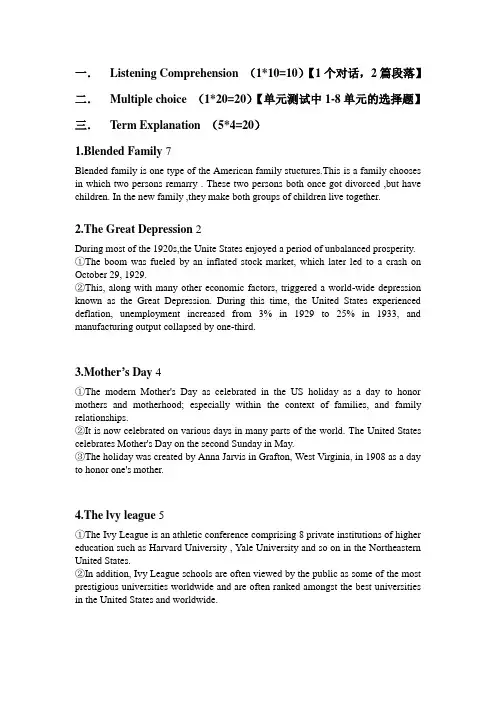
一.Listening Comprehension (1*10=10)【1个对话,2篇段落】二.Multiple choice (1*20=20)【单元测试中1-8单元的选择题】三.Term Explanation (5*4=20)1.Blended Family 7Blended family is one type of the American family stuctures.This is a family chooses in which two persons remarry . These two persons both once got divorced ,but have children. In the new family ,they make both groups of children live together.2.The Great Depression 2During most of the 1920s,the Unite States enjoyed a period of unbalanced prosperity.①The boom was fueled by an inflated stock market, which later led to a crash on October 29, 1929.②This, along with many other economic factors, triggered a world-wide depression known as the Great Depression. During this time, the United States experienced deflation, unemployment increased from 3% in 1929 to 25% in 1933, and manufacturing output collapsed by one-third.3.Mother’s Day 4①The modern Mother's Day as celebrated in the US holiday as a day to honor mothers and motherhood; especially within the context of families, and family relationships.②It is now celebrated on various days in many parts of the world. The United States celebrates Mother's Day on the second Sunday in May.③The holiday was created by Anna Jarvis in Grafton, West Virginia, in 1908 as a day to honor one's mother.4.The lvy league 5①The Ivy League is an athletic conference comprising 8 private institutions of higher education such as Harvard University , Yale University and so on in the Northeastern United States.②In addition, Ivy League schools are often viewed by the public as some of the most prestigious universities worldwide and are often ranked amongst the best universities in the United States and worldwide.5.Affirmative Action 7①Affirmative action is a policy or program intended to promote access to education or employment for minority groups and women.②Motivation for affirmative action policies is to redress the effects of past discrimination and to encourage public institutions such as universities, hospitals, and police forces to be more representative of the population.6.The Bill of Rights 3①The Constitution has twenty-seven amendments. The first ten, collectively known as the Bill of Rights, were ratified simultaneously by 1791. The following seventeen were ratified separately over the next two centuries.②They were introduced by Jame Madison and Thomas Jefferson was a supporter of the bill of rights.③For example , First Amendment–freedom of speech, of the press, Freedom of Religion, and of assembly; right to petition..Third Amendment–Protection from quartering of troops.7.April Fool’s Day 4①April Fool’s Day is a day celebrated in many countries on April 1.②The day is marked by the commission of hoaxes and other practical jokes of varying sophistication on friends,family members,enemies,and neighbors.③April Fool's Day thus developed into an international fun fest, so to speak, with different nationalities specializing in their own brand of humor at the expense of their friends and families.8.SAT 5①Scholastic Assessment Test and Scholastic Aptitude Test②The SAT and ACT are the most common standardized tests that students take when applying to college.③Most competitive schools also require two or three SAT Subject Tests, (formerly known as SAT IIs), which are shorter exams that focus strictly on a particular subject matter.④Possible scores range from 600 to 2400, combining test results from three 800-point sections . Including math critical reading and writing .四.True or False (1*10=10)【教学课件中的内容】五.Questions (10*2=20)1.What are the advantages and disadvantages of jury system(陪审团制度) in the Judicial System(司法系统)of the United States?3 Advantages:Firstly, it is formed by ordinary people who have different kinds of jobs. Secondly , it is democratic . Thirdly , it help to enhance the credibility of the trial(提高审判公信力. Fourthly , it has law-making function(造法功能). The last , it also has educational function(教育功能)Disadvantages:Firstly,most members of the jury do not have the legal expertise(缺乏法律专业知识). What’s more, if the Government cannot protect the jury well , the situation that the jury is being bought off or being threatened will be frequently happen. This will enable the upper social strata to have a good umbrella.(如果政府对陪审团保护不利的情况下,很容易发生陪审团被买通被威胁的事件,这样使社会上层人士有个很好的保护伞。
当代美国社会与文化的后现代特征探析后现代是什么意思工业革命的成功将西方资本主义社会导入了现代历史阶段。
由美国革命和法国大革命所开创的现代社会具有“市民社会”(civil society)的性质,是一种基于个人自由民主和基本人权的法制社会,其基本特征和“现代性”在于:把社会视为由具有自由平等权的个人,依据其个人意愿和基本利益,而按照协商民主方式达到共识的途径所建构起来的。
换言之,自然权利论和社会契约论,是现代社会和现代国家的建构基础,其政治意义在于牵制国家权力的膨胀。
20世纪60年代是美国社会转入后现代历史阶段的起点。
在经历了两次世界大战的激烈动荡以及20世纪半个多世纪政治、经济和文化的激烈变革之后,在当代科技革命和信息技术的影响和推动下,美国率先步入了“后工业社会”或“信息社会”时代,从经典资本主义过渡到了晚期资本主义。
当代美国的“后现代性”充满着矛盾性和吊诡性:一方面,社会政治、经济和文化都实现了高度的理性化、制度化和专业化,先进的知识和技术高速发展,精神财富和物质财富空前繁荣,带来了空前未有的“休闲式”或“消费式”的轻松惬意的日常生活结构;另一方面,社会政治、经济和文化的法制化、专业化和体系化以及科学技术的意识形态化,正在日渐脱离日常生活领域,开始走向与“生活世界”的尖锐对立,并对公民生活进行潜移默化的“殖民化”或“宰制”,这一切不仅直接破坏了美国社会本身现存的和谐关系,而且对美国社会与文化的未来走向产生着间接的负面影响。
二当代美国社会的后现代特征“理性异化”和“科技专制”(technocracy),使当代美国的社会性质和结构发生了根本性的变化。
首先,启蒙理性已经异化为科学理性、工具理性和极权理性,成为凭借权力控制一切、征服一切的基础和工具。
理性的异化逐渐消解了人的主体性,并最终导致了人性的扭曲和社会的变异。
其次,技术专家同权力机构相互勾结,赋予当代科学技术和知识一种新的特权地位,形成对当代美国社会的“科技专制”,使效率和技术统治意识取代了自由、平等和社会进步意识,成为衡量一切的最高标准和控制人、奴役人的异己力量。
美国社会与文化Part I Geography1. The two newest states Alaska and Hawaii are separated from the continental United States: Alaska borders on northwestern Canada, and Hawaii lies in the central Pacific. 阿拉斯加与加拿大西北部接壤,夏威夷则位于太平洋中部。
2. Of all the states of America, Alaska is the largest in area and Rhode Island the smallest. But on themainland Texas is the largest state of the country.阿拉斯加是美国面积最大的州,罗得岛州最小。
而在美国大陆,最大的州是德克萨斯州。
3. The Rockies, the backbone of the North American continent, is also known as the Continental Divide.落基山脉是北美大陆的脊梁,也被称为大陆分水岭。
4. The two main mountain ranges in America are the Appalachian Mountains and the Rocky mountains. The Appalachians run slightly from northeast tosouthwest and the Rocky Mountains run slightly from northwest to southeast.阿巴拉契亚山脉和落基山脉是美国的两座达山脉。
阿巴拉契亚山脉略呈东北至西南走向,而落基山脉略呈西北至东南走向。
认识美国的社会与文化余嫔一、文化差异一般人谈文化差异,其实谈的是「同中有异」的「异」的部分,是以一个整体的观点来谈文化的普遍倾向,并不去提在大文化之下的个别差异。
许多对某一文化粗略的假设或前题,如:法国人浪漫、犹太人吝啬、美国人个人主义等等,或者深入的研究探讨资料,都有助于我们对一个文化的认识,当与不同文化的个别接触时,个别差异仍是不可忽视的。
过度的以偏概全或刻板印象,有时也会使我们不能真正的了解别人。
其实人类文化的发展,受环境和人本身条件的限制,是有许多相似之处,但由于价值观、生活方式和历史背景的不同,不同社会的人对事情或生活的喜好、选择、符号的解释和行为表现便有差异。
由于传播媒体的发达和交通工具的便利,现今完全不受其他文化影响的例子已很少,而在二十一世纪以「我们都是一个地球的居民」的意识高涨之际,各人种之间的接触和彼此的影响愈来愈深广。
接触其他文化将成为「现代公民」的一种必要的经验,而适应文化差异也将成为现代公民的必要能力之一。
来美国求学,尤其是到洛杉矶这样的国际大都会,有许多机会面对各类人种,是接触许多文化不可多得的机会,同时也是一个极大的挑战。
二、文化震撼与调适「文化震撼」(Culture Shock)主要是来自于两个不同文化差异而引起。
可以发生在任何时候,任何新环境。
当你到达一个地方觉得很陌生、很困惑,不知道自己的角色是什么、应定位在哪里?应怎么表现才恰当等等,觉得很不舒服、很不自在时,就是"shock"。
好像过去所有的经验在刹那间突然「短路」。
很多时候,「文化震撼」会引起身体上的一些症状:如头痛、胃囗不好、睡眠失调或者心理上的焦虑、沮丧。
几乎每一个留学生都经验过文化震撼,只是有时当事人并不清楚知道自己正在经历或曾经有过。
其实文化震撼并不是指突发一次即结束的"shock"的感觉,而是在一段时间内,密集式的有强有弱的震惊,仓惶和被冲击到的感觉。
过去的文化背景和新文化差异愈大时,震撼的感觉会愈强且愈密集。
美国社会与文化、基本信息二、课程描述《美国社会与文化》是一门为英语语言文学学生开设的专业选修课,旨在提高学生对美国社会与文化的了解,整个课程涵盖面较广,涉及美国文明的方方面面。
就美国文化而言, 它包括宗教、文化区域、价值观、大众媒体和民族特性等。
就美国社会而言,它包括政治制度、种族关系、妇女运动、劳工组织和社会福利等。
三、教学目标通过本课程的学习,使学生具备如下能力:1. 了解美国历史、政治、文化的相关知识2.掌握美国历史、政治学、社会学和国际关系学的基本理论知识3.增强学生人文素养,帮助他们理解英语语言背后的文化,为中美文化交流奠定基础。
4.有助于培养社会主义市场经济对外语所需的综合人才5.有助于学生客观地了解美国,而且有助于提高他们的观察和思辨能力。
6.为学生今后高年级阶段的学习打下文化背景、自主学习、科学研究的跨学科思维与学习基础。
四、课程目标对毕业要求的支撑五、教学内容Introduction (支撑课程目标1、2、3、4、5、6)重点内容:课程介绍难点内容:课程教学理念及方法教学内容:课程介绍,教学理念及方法介绍,学期要求等Unit 1 American Politics(支撑课程目标1、2、3、4、5、6)重点内容:Textl难点内容:美国政治制度教学内容:完成第1单元课文的学习, 学习及课后习题,课堂批判思考与发言。
Unit 2 Ethnic Groups (支撑课程目标1、2、3、4、5、6)重点内容:Textl难点内容:美国种族现状教学内容:完成第2单元课文的学习, 学习及课后习题,课堂批判思考与发言。
Unit 3 Woman's movements (支撑课程目标1、2、3、4、5、6)重点内容:Textl难点内容:美国妇女运动教学内容:完成第3单元课文的学习,学习及课后习题,课堂批判思考与发言。
Unit 4 Social Welfare(支撑课程目标1、2、3、4、5、6) 学习及课后习题,课堂批判思考与发言。
一.Listening Comprehension (1*10=10)【1个对话,2篇段落】二.Multiple choice (1*20=20)【单元测试中1-8单元的选择题】三.Term Explanation (5*4=20)1.Blended Family 7Blended family is one type of the American family stuctures.This is a family chooses in which two persons remarry . These two persons both once got divorced ,but have children. In the new family ,they make both groups of children live together.2.The Great Depression 2During most of the 1920s,the Unite States enjoyed a period of unbalanced prosperity.①The boom was fueled by an inflated stock market, which later led to a crash on October 29, 1929.②This, along with many other economic factors, triggered a world-wide depression known as the Great Depression. During this time, the United States experienced deflation, unemployment increased from 3% in 1929 to 25% in 1933, and manufacturing output collapsed by one-third.3.Mother's Day 4①The modern Mother's Day as celebrated in the US holiday as a day to honor mothers and motherhood; especially within the context of families, and family relationships.②It is now celebrated on various days in many parts of the world. The United States celebrates Mother's Day on the second Sunday in May.③The holiday was created by Anna Jarvis in Grafton, West Virginia, in 1908 as a day to honor one's mother.4.The lvy league 5①The Ivy League is an athletic conference comprising 8 private institutions of higher education such as Harvard University , Yale University and so on in the Northeastern United States.②In addition, Ivy League schools are often viewed by the public as some of the most prestigious universities worldwide and are often ranked amongst the best universities in the United States and worldwide.75.Affirmative Action is a policy or program intended to promote access to education Affirmative action①or employment for minority groups and women.past of redress the effects affirmative action policies is to ②Motivation for discrimination and to encourage public institutions such as universities, hospitals, and police forces to be more representative of the population.36.The Bill of RightsThe Constitution has twenty-seven amendments. The first ten, collectively known ①, were ratified simultaneously by 1791. The following seventeen Bill of Rights as the were ratified separately over the next two centuries.They were introduced by Jame Madison and Thomas Jefferson was a supporter of ②the bill of rights.of press, Freedom of freedom of speech, the ③For example , First Amendment–from Protection Third Amendment–Religion, and of assembly; right to petition.. quartering of troops.7.April Fool's Day 4①April Fool's Day is a day celebrated in many countries on April 1.②The day is marked by the commission of hoaxes and other practical jokes of varying sophistication on friends,family members,enemies,and neighbors.③April Fool's Day thus developed into an international fun fest, so to speak, with different nationalities specializing in their own brand of humor at the expense of their friends and families.8.SAT 5①Scholastic Assessment Test and Scholastic Aptitude Test②The SAT and ACT are the most common standardized tests that students take when applying to college.③Most competitive schools also require two or three SAT Subject Tests, (formerly known as SAT IIs), which are shorter exams that focus strictly on a particular subject matter.④Possible scores range from 600 to 2400, combining test results from threewriting .critical reading and 800-point sections . Including math四.True or False (1*10=10)【教学课件中的内容】五.Questions (10*2=20)1.What are the advantages and disadvantages of jury system(陪审团制度) in the Judicial System(司法系统) of the United States?3Advantages:Firstly, it is formed by ordinary people who have different kinds of jobs. Secondly , it is democratic . Thirdly , it help to enhance the credibility of the trial(提高审判公信力. Fourthly , it has law-making function(造法功能). The last , it also has educational function(教育功能)Disadvantages:Firstly,most members of the jury do not have the legal expertise(缺乏法律专业知识). What's more, if the Government cannot protect the jury well , the situation that thejury is being bought off or being threatened will be frequently happen. This will enable the upper social strata to have a good umbrella.(如果政府对陪审团保护不利的情况下,很容易发生陪审团被买通被威胁的事件,这样使社会上层人士有个很好的保护伞。
当代美国社会与文化
细读王恩铭老师的《当代美国社会与文化》确实收获很多,惊叹于作者对全书系统有序且相当全面的介绍了美国的民族构成、政治制度、经济发展、教育体系、大众传媒、劳工组织、企业管理、社会保障、电影艺术和体育活动,并对美国的宗教信仰、区域文化、价值观念、家庭婚姻、妇女运动和社会矛盾等问题。
和其他书籍来比,譬如我以前读过的《纽约地标》、《裸视美国》等,该书作者的逻辑更加清晰,篇章安排也比较合理。
比如说就整体结构而言,本书分为十九个篇章,分别从美国社会的各个层面出发板块式分别叙述了诸如地理、人口、区域划分,历史,民族构成,政治制度,经济概貌,教育概貌,宗教价值观,大众传播媒介,美国劳工及劳工运动,美国工业组织及企业管理,妇女与妇女运动,家庭与婚姻,美国社会保障制度,美国社会问题,以及美国人的娱乐活动,主要节日等。
条理清晰,分类严谨,给人以清新,简单的印象。
而就每一个篇章来说,作者在一开始都会有一个概括性的引言。
这样的引言简明扼要,提纲挈领性的告诉我们这一章将要讲的内容,使读者对作者的思路有了一个简明的了解。
然后在下文的叙述中,不同于有些书籍的是作者分了好多小标题,又一次简明的作为提示性的关键词放在显著位置,使得读者读起来更加方便,也调动了读者的积极性。
其实如此学术性的书籍常常会失于乏味,但是读这本书时,每每看完作者的引言和小标题,我常常会想象作者接下了会怎样写,如
果是我会怎样写,就这一方面我已经了解了哪些问题等等,这样就提高了我阅读的积极性。
我想分类明了,思路严谨,行文脉络清晰是本书最大的特征之一。
就是利用这种方法,作者很明白的把整个美国社会的组成以文化现象说的很清楚。
这种行文方式,也是我们以后写作时应该效仿学习的。
给我印象最深的一节是关于美利坚民族构成的介绍,和以前看过的书相比,作者明了的分类方式,抓住纲领的行文可见一斑。
该章开始,作者用简短不足一千字的六小段,简单的介绍了这个多民族的移民国家的形成,组成,文化特征勾勒出了美利坚民族的基本特色。
然后作者又利用他的分类特长分别介绍了北美土著居民,来自欧洲的居民,来自亚洲的居民,来自非洲的居民,来自拉丁美洲的美国人,这样的分类系统简单明了,易于接受。
然后作者又按同样的结构在每个小节分别叙述了这些居民主要来自这些大洲的哪些国家,这些国家的移民在当今美国所占的比例,以及他们的移民史,他们第一代移民的从事的职业,社会地位以及第二代,第三代……的移民的职业特征,社会地位,和与其他国家移民相比,各个国家的移民的不同点。
比起以前所读过的《裸视美国》,这样的叙述更清晰,思路更简单,更易为读者所接受。
通观全书,我对美国社会有了更系统的了解。
其实对于书上的有些知识我以前零星点点的略知皮毛,但是在作者引领下我有了更清楚的认识。
还有一些知识是以前在别的书上很少读过的,比如说以前我只知道美国白人的奴隶制度和他们对黑人的残酷剥削,但是不明白白
人是怎样统治黑人的,黑人又是怎样反抗的,而这些反抗又为什么会以失败告终等等,而书上都有系统的介绍。
尤其是奴隶主在心理文化上控制奴隶的办法给我留下了很深的印象。
比如,奴隶主制定法律,明确规定教授奴隶识字属于犯法行为,以确保奴隶始终处于愚昧无知的状态。
此外,他们还通过安排奴隶生活所需品,管理奴隶起居生活,潜移默化的腐蚀他们的独立自主的精神,使奴隶最终养成依附,依赖奴隶主的习惯。
其实,我觉得何止那些早期的种植园主,就算是在封建统治的中国,统治者不也是通过控制人们的思想,实行愚民政策,以巩固其通知吗?
此外,我更加系统的明白了美国的政治制度,比如美国的宪法,美国的三权分立的制衡理论(真觉得他们的制度很聪明的),人权法案,国会,法院,以及总统的选举、权力和其下属行政部门,美国的政党,以及很具美国特色的各种利益团体。
其中,就三权分立,我觉得其实总统的权利,应该是最大的。
且不说其在外交事务中享有的重大权力。
单单是在行政权中,虽然宣战权属于国会但是总统常常会不宣而战。
还有,虽然立权权属于国会,但是总统有否决国会通过的一切法案的权利,尽管参众两院可以各以三分之二的多数票推翻总统的否决,但是“口袋否决”(pocket vote),也可以使法案不能成为法律,此外,总统还可以利用他的威望,诉诸公共舆论,影响国会的立法进程。
还有,在司法权力中,总统有权任命联邦高级司法官员,还有他可以对任何被判处犯联邦法律的人做完全或有条件的赦免。
所以,我觉得尽管三权分立,但有些权力向总统倾斜。
其实,我觉得尽管我们提及美国时常常提及她的自由,民权,认为她是一个民有、民治、民享的国家,但是我觉得这可能是近几十年,尤其是二战以来他的经济高速发展给人民留下一些误解吧!其实,尽管她崇尚宗教信仰自由,但是在宗教观念浓重的社会中,作为少数分子的人人常常会被排斥,所以有些人加入某些宗教、社团等等仅仅是为了寻找一种归属感,一种心灵庇护和一种社会认可。
的确,在这个文化高度自由的国度存在着摩门教,伊斯兰教,禅宗教,还有各种非鬼非神的怪胎性教派等共250多种派别。
但这并不意味着你可以绝对自由的选择,比如在1933年,美国联邦政府就对德克萨斯韦口“邪教”进行大举镇压,事实上美国政府也要求宗教组织在其所规定的法律框架中活动。
此外,就美国妇女而言,其实在独立战争之前和之后的一段时期,和其他国家一样她们的政治,经济,法律和社会地位都很卑微的。
曾经她们也像中国古代的封建社会的妇女一样未嫁从父,已嫁从夫的生活着,只是近些年来的妇女运动改变了她们这种状况。
美国人的婚姻也不是向我们想的那样自由,诚然肯定会有冲破界限的佳话的传颂,但是在实际进行的过程中是受家庭、社会、宗教和种族等因素的影响,尤其是美国巨富家庭中的父母,往往对子女的婚事干预比较多。
总之我觉得的确学到很多,但是我觉得该书也有其缺点。
一本小小的只有400页的书不可能详尽的介绍整个美国社会光怪陆离的社会现象,也不可能把如此复杂的美国剖析的详尽。
可能是行文的需要吧,总觉得作者有时候没有把一件事情说明白,就匆匆忙忙的去说另
一件事情。
比如就其介绍利益集团这一章时,讲了好多集团,但是就其如何组织,如何运营等等都没有提及或者一笔带过,给人一种过于仓促的感觉。
此外在其介绍美国现代家庭的生活方式时,作者提到了群居式大家庭,并且把其放在一很重要的位置,但仅仅用了4行来说明,我觉得过于简单。
因为对于群居式大家庭这种新兴生活方式我们本身就不怎么了解,要想说清楚应该更加详尽一点。
还有,在介绍美国娱乐业时,作者有一段是这样写的“二战结束后,美国电影走出低谷,再创辉煌”,但是在这一段中作者写了这样一句话40年代末,美国国内掀起一场反共热潮,其影响涉及到美国电影圈的很多人员,在一个所谓的“非美活动委员会”的调查下,美国电影界备受干扰。
这句话就让我很迷惑,在没有很多知识储备的情况下,很难读懂。
我想作者应该之神说一下收到了什么样的干扰。
此外,尽管全书已经很有逻辑,但是我觉得妇女与妇女运动,作为一个单独的章节并不太好,因为其只属于众多美国社会现象的一种,如果这也算得话,那么美国黑人运动是不是也应该再分一章了呢?还有在美国的政治中,我觉得应该加入他的外交政策,但是全书好像从没提过美国的外交政策。
我觉得自己有点吹毛求疵了,这样小的一本书,能够写的如此详尽且有条理已经很难得了,再说如此纷繁的社会,作者难免会有遗漏。
或许这些仅仅也只是我个人一点不正确的看法。
但王恩铭老师的这本书,真的是我读过的书中觉得最系统,最有条理的一本,诚然会有不足,但瑕不掩瑜。